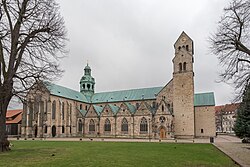
Back Hildesheim Afrikaans Hildesheim ALS Hildesheim AN هيلدسهايم Arabic هيلدسهايم ARZ هیلدسهایم AZB Хильдесхайм Bashkir Hildesheim BAN Гільдэсгайм Byelorussian Хилдесхайм Bulgarian
Hildesheim
| |
|---|---|
|
Clockwise from top: St. Mary's Cathedral (UNESCO World Heritage Site), half-timbered houses at the Brühl street, St. Andrews Church, St. Michael's Church (UNESCO World Heritage Site), Roemer- und Pelizaeus-Museum and the Historic Market Place | |
Location of Hildesheim within Hildesheim district  | |
| Coordinates: 52°09′N 09°57′E / 52.150°N 9.950°E | |
| Country | Germany |
| State | Lower Saxony |
| District | Hildesheim |
| Government | |
| • Lord mayor (2021–26) | Ingo Meyer[1] (Ind.) |
| Area | |
| • Total | 92.18 km2 (35.59 sq mi) |
| Elevation | 81 m (266 ft) |
| Population (2022-12-31)[2] | |
| • Total | 101,858 |
| • Density | 1,100/km2 (2,900/sq mi) |
| Time zone | UTC+01:00 (CET) |
| • Summer (DST) | UTC+02:00 (CEST) |
| Postal codes | 31134–31141 |
| Dialling codes | 05121 |
| Vehicle registration | HI, ALF |
| Website | www.hildesheim.de |
| UNESCO World Heritage Site | |
|---|---|
 Ottonian architecture in St. Michael's Church | |
| Criteria | Cultural: i, ii, iii |
| Reference | 187 |
| Inscription | 1987 (11th Session) |
| Area | 0.58 ha |
| Buffer zone | 157.68 ha |
Hildesheim (German: [ˈhɪldəsˌhaɪm] ; Low German: Hilmessen or Hilmssen; Latin: Hildesia) is a city in Lower Saxony, in north-central Germany with 101,693 inhabitants.[3] It is in the district of Hildesheim, about 30 km (19 mi) southeast of Hanover on the banks of the Innerste River, a small tributary of the Leine River.
The Holy Roman Emperor Louis the Pious founded the Bishopric of Hildesheim in 815 and created the first settlement with a chapel on the so-called Domhügel.
Hildesheim is situated on the north–south Autobahn 7, and hence is connected with Hamburg in the north and Austria in the south.
With the Hildesheim Cathedral and the St. Michael's Church, Hildesheim became a UNESCO World Heritage Site in 1985.
In 2015 the city and the diocese celebrated their 1200th anniversary.
- ^ "Direktwahlen in Niedersachsen vom 12. September 2021" (PDF). Landesamt für Statistik Niedersachsen. 13 October 2021.
- ^ "LSN-Online Regionaldatenbank, Tabelle A100001G: Fortschreibung des Bevölkerungsstandes, Stand 31. Dezember 2022" (in German). Landesamt für Statistik Niedersachsen.
- ^ https://www.hildesheim.de/pics/verwaltung/1_1549983673/Bevoelkerung_der_Stadt_Hildesheim_HW_31.12.2019.pdf [dead link]









